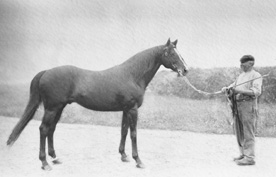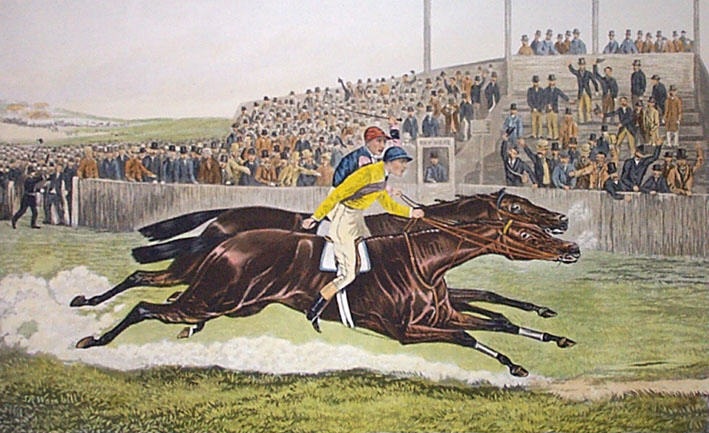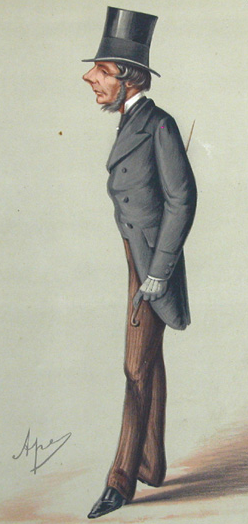|
John Porter (horseman)
John Porter (2 March 1838 – 21 February 1922) was an English Thoroughbred flat racing trainer whose horses won the English Triple Crown three times. He was described by the National Horseracing Museum as "undoubtedly the most successful trainer of the Victorian era." He was also the founder of Newbury Racecourse in Berkshire, England. Background Born in Rugeley, Staffordshire, His father was a tailor and his mother a dressmaker. He left school in 1852, as his father was eager for him to join the legal profession. However, John Porter visited John Day’s stables while on holiday and was impressed with what he saw. In 1853 John Porter (aged 15) was apprenticed to John Day, who trained racehorses principally for lawyer Henry Padwick, at Michel Grove, near Worthing, Sussex. The stable moved to Findon, Sussex in 1857. Soon after the move, John Day left Findon after a disagreement with Mr Padwick, and Porter's apprenticeship was terminated. He stayed at Findon under Willi ... [...More Info...] [...Related Items...] OR: [Wikipedia] [Google] [Baidu] |
Liborio Prosperi
Liborio Prosperi ('Lib') Liberio Prosperi (Foligno, 1854 – Foligno, 1928), was an Italian-born artist who belonged to a group of international artists producing caricatures for the British ''Vanity Fair'' magazine. He contributed 55 caricatures between 1885 and 1903, signed 'Lib', and concentrating mainly on the racing set. His 1886 multi-portrait caricature ''The Lobby of the House of Commons'' is on view in the Victorian Gallery of the National Portrait Gallery in London. The figures depicted by the artists of ''Vanity Fair'' included royalty, statesmen, scientists, authors, actors, soldiers, scholars and sporting men. Prospei's prints in the National Portrait Gallery Collecti ... [...More Info...] [...Related Items...] OR: [Wikipedia] [Google] [Baidu] |
Prince Of Wales's Stakes
The Prince of Wales's Stakes is a Group 1 flat horse race in Great Britain open to horses aged four years or older. It is run at Ascot over a distance of 1 mile 1 furlong and 212 yards (2,004 metres), and it is scheduled to take place each year in June. History The event was established in 1862, and it was named after the Prince of Wales at that time, the future King Edward VII. The original version was restricted to three-year-olds, and it was contested over 1 mile and 5 furlongs. The race was discontinued after World War II, when there was no Prince of Wales. It returned in 1968, a year before the investiture of Prince Charles. The distance of the new version was 1 mile and 2 furlongs, and it was now open to horses aged three or older. The present system of race grading was introduced in 1971, and for a period the Prince of Wales's Stakes was classed at Group 2 level. It was promoted to Group 1 status in 2000, and at this ... [...More Info...] [...Related Items...] OR: [Wikipedia] [Google] [Baidu] |
Flying Fox (horse)
Flying Fox (1896–1911) was a champion British Thoroughbred racehorse who won the 1899 English Triple Crown and was the leading sire in France three times. Background He was sired by Orme who in turn was sired by Ormonde, the 1886 Triple Crown winner. Their victories made owner Hugh Grosvenor, 1st Duke of Westminster, the only person to own two English Triple Crown winners. His dam was the high-strung mare, somewhat aptly named Vampire, by Galopin. Vampire also produced these horses from six matings with Orme: Flying Lemur (£1,325, a stud failure); Vamose (£5,604 and at stud in France with limited success) and Pipistrello (a non-winner and useless as a stallion), Wetaria, and Vane (produced the Royal Hunt Cup and Ebor Handicap winner, Weathervane). Flying Fox was intensely inbred (3m x 2f) to Galopin.Morris, Simon; ''Tesio Power 2000 - Stallions of the World'', Syntax Software Racing career Flying Fox was a very difficult colt to handle and only raced for two years. Howev ... [...More Info...] [...Related Items...] OR: [Wikipedia] [Google] [Baidu] |
La Fleche (horse)
La Fleche (1889–1916) was a British Thoroughbred racehorse and broodmare. After being sold for a world record price as a yearling in 1890, she was undefeated as a two-year-old in 1891, winning races against her own sex and defeating some of the year's leading colts. She went on to become the dominant British three-year-old of 1892, claiming the Fillies’ Triple Crown by winning the 1000 Guineas at Newmarket, the Oaks at Epsom and the St Leger at Doncaster. Her only defeat of the year came when she finished second when starting favourite for The Derby. La Fleche remained in training for a further two seasons, winning important races such as the 1893 Liverpool Autumn Cup, the 1894 Ascot Gold Cup, and the Champion Stakes on her final appearance. In all, she won sixteen times in twenty-four racecourse appearances. After her retirement from racing she became a successful and influential broodmare. Background La Fleche ( French for ''The Arrow''), a brown mare standing ... [...More Info...] [...Related Items...] OR: [Wikipedia] [Google] [Baidu] |
Orme (horse)
Orme (1889 – 17 September 1915) was a British Thoroughbred racehorse. He was trained at Kingsclere by John Porter for the 1st Duke of Westminster. As a two-year-old he won the Middle Park and Dewhurst Stakes. As a three-year-old he was not well enough to take part in the 2000 Guineas and Epsom Derby, but came back to win the Eclipse Stakes. Orme stayed in training as a four-year-old and won another Eclipse Stakes, becoming the first horse to win the race twice, a feat that has only been repeated four times since. After he had retired from racing, he became a successful sire and was Champion sire of Great Britain in 1899. His son Flying Fox won the Triple Crown and the Eclipse Stakes. Orme also sired Epsom Derby winner Orby and 1000 Guineas winner Witch Elm. His regular jockeys were George Barrett and Morny Cannon. Background Orme was a bay colt born in 1889 at Eaton Stud in Cheshire. He was bred by the 1st Duke of Westminster. Orme stood 16 hands high and had a lar ... [...More Info...] [...Related Items...] OR: [Wikipedia] [Google] [Baidu] |
Common (horse)
Common (1888–1912) was a British Thoroughbred racehorse and sire. In a career that lasted from May to September 1891 he ran five times and won four races. He became the fifth, and the most lighty-raced horse to win the English Triple Crown by winning the 2000 Guineas at Newmarket, the Derby at Epsom and the St Leger at Doncaster. Background Common was a “big, lathy, sinewy” brown horse, standing just over 16 hands high bred at Crichel in Dorset by Henry Sturt, 1st Baron Alington who owned him during his racing career in partnership with Sir Frederick Johnstone. The colt was sent into training with John Porter at Kingsclere, and was ridden in all his races by George Barrett. Common's sire Isonomy was one of the outstanding British racehorses of the 19th Century, winning the Ascot Gold Cup in 1879 and 1880. He went on to become a successful stallion; apart from Common he sired Isinglass, thus being the first of two horses to father two winners of the Englis ... [...More Info...] [...Related Items...] OR: [Wikipedia] [Google] [Baidu] |
Friar's Balsam (horse)
Friar's Balsam (1885–1899) was an English Thoroughbred racehorse. He was the outstanding British two-year-old of 1887, when he was unbeaten in seven races. He was a sick horse when a beaten favourite in the following year's 2000 Guineas, but returned in the autumn to beat Minting in the Champion Stakes. Friar's Balsam was retired to stud where he had some success as a sire of winners. He was trained at Kingsclere by John Porter for Lord Alington and Sir Frederick Johnstone. Breeding Friar's Balsam was a chestnut colt foaled in 1885. His conformation was not perfect, as he was described as being "very much over at the knee". Friar's Balsam's sire was The Derby winner Hermit. His dam, Flower of Dorset, was sired by Breadalbane out of the Park Hill Stakes winner Imperatrice, the founder of Thoroughbred family 2-k. Racing career 1887: two-year-old season Friar's Balsam began his racing career in the New Stakes at Ascot. In a field of seven that included Seabreeze and ... [...More Info...] [...Related Items...] OR: [Wikipedia] [Google] [Baidu] |
Orbit (horse)
Orbit (foaled 1885) was a Thoroughbred racehorse. He was trained at Kingsclere by John Porter for the 1st Duke of Westminster. As a three-year-old he won the Eclipse Stakes. Breeding Orbit was the son of Epsom Derby and Champion Stakes winner Bend Or. His dam was Fair Alice, a daughter of July Stakes winner Cambuscan. Racing career Orbit won three races as a two-year-old; the Criterion Nursery Handicap at Newmarket, the Kempton Park Champion Nursery Handicap and the Daveridge Stakes. Orbit started his three-year-old career by winning the Craven Stakes at Newmarket by ¾ length from Cotillon. His next race came in the 2000 Guineas at Newmarket. Friar's Balsam started as the 1/3 favourite for the race, with Ayrshire at 100/12 and Orbit at 100/8. Orbit ran on well in the closing stages to finish in third place. Ayrshire won the race by two lengths from Johnny Morgan, who was a head in front of Orbit. After winning the 2000 Guineas win Ayrshire started as the 5/6 favourite for ... [...More Info...] [...Related Items...] OR: [Wikipedia] [Google] [Baidu] |
Ormonde (horse)
Ormonde (1883–1904) was an undefeated English Thoroughbred racehorse who won the 1886 English Triple Crown and was labelled the 'horse of the century' at the time. He also won the St. James's Palace Stakes, Champion Stakes and the Hardwicke Stakes twice. Ormonde was trained at Kingsclere by John Porter for the 1st Duke of Westminster. His regular jockeys were Fred Archer and Tom Cannon. After retiring from racing he suffered fertility problems, but still sired Orme, who won the Eclipse Stakes twice. Background Ormonde was a bay colt, bred by Hugh Grosvenor, 1st Duke of Westminster and foaled in 1883 at Eaton Stud in Cheshire. Ormonde's sire was The Derby and Champion Stakes winner Bend Or, also bred by the Duke. Bend Or was a successful stallion, his progeny included Kendal, Ossory, Orbit, Orion, Orvieto, Bona Vista and Laveno. Ormonde's dam was Doncaster Cup winner Lily Agnes. She was sired by another Derby winner, Macaroni. Lily Agnes began to experience problems w ... [...More Info...] [...Related Items...] OR: [Wikipedia] [Google] [Baidu] |
Paradox (horse)
Paradox (1882–1890) was a British Thoroughbred racehorse and sire. In a career that lasted from October 1884 until October 1885 he ran eight times and won six races. Despite running only twice in 1884, he proved himself to be one of the best two-year-olds of his generation by winning the Dewhurst Plate. In the following year he won five of his six races including the 2,000 Guineas, the Grand Prix de Paris, the Sussex Stakes and the Champion Stakes. His only defeat came when he was narrowly beaten by Melton in The Derby. The final phase of the colt's racing career was marked by controversy and recrimination following his withdrawal from the Cambridgeshire Handicap in the autumn of 1885 and he was retired from racing in 1886. Paradox had little opportunity to establish himself at stud, dying in 1890 at the age of eight. Background Paradox was a strongly-built bay horse bred by the Graham brothers at the Yardley Stud near Birmingham. He was sired by the 2,000 Guineas ru ... [...More Info...] [...Related Items...] OR: [Wikipedia] [Google] [Baidu] |
Shotover (horse)
Shotover (1879–1898) was a British Thoroughbred racehorse and Horse breeding#Terminology, broodmare. In a career that lasted from 1882 to 1884, she ran 15 times and won five races. As a three-year-old, racing against colts, she became the first filly to win the first two legs of the Triple Crown of Thoroughbred Racing, English Triple Crown: the 2000 Guineas at Newmarket Racecourse, Newmarket and the Epsom Derby, Derby at Epsom Downs Racecourse, Epsom. She went on to win twice at Royal Ascot, but failed in her bid for the Triple Crown when she finished third in the St. Leger Stakes, St Leger at Doncaster Racecourse, Doncaster. She was retired in 1884 and became a successful and influential broodmare. Shotover died in 1898. Background Shotover was a powerfully built chestnut filly with a white Horse markings, star, standing just under 15.3 Hand (unit), hands high, who was praised for her "lean and game-looking" head and "beautifully formed" legs. She was bred by Henry Chaplin, 1s ... [...More Info...] [...Related Items...] OR: [Wikipedia] [Google] [Baidu] |
Isonomy (horse)
Isonomy (May 1875 – April 1891) was a British Thoroughbred racehorse and sire. In a career that lasted from 1877 to 1880 he ran fourteen times and won ten races. As a three-year-old he deliberately bypassed the Classics in order that his owner could land a massive betting coup in the Cambridgeshire Handicap at Newmarket. In the following two seasons he was the dominant stayer in Britain, producing a series of performances which led many contemporary observers to regard him as one of the greatest racehorses of the 19th century. He was then retired to stud, where he became a successful stallion. Background Isonomy was a late foal, being born in May 1875, and as a result he was, in his early life, smaller and less physically developed than other colts of his generation. Even in full maturity, he was not a large horse, standing just under 15.2 hands high. He was bred at the Yardley stud near Birmingham by the Graham brothers. When the leading trainer John Porter visited th ... [...More Info...] [...Related Items...] OR: [Wikipedia] [Google] [Baidu] |





